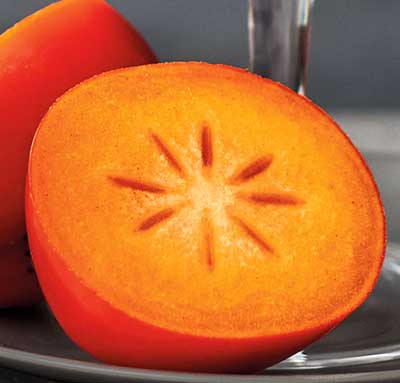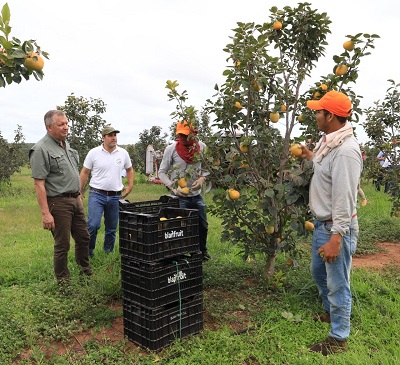Introducing the "Bright Red" Persimmon

The Rojo Brilliante, which translates to "Bright Red," is traditionally grown in the region of Valencia, in southern Spain. Its thin skin transitions from a subtle yellowish hue to an eye-popping orange-red as the fruit ripens. When ripe, it offers an intense burst of sweetness and flavor.
The tasty Bright Red persimmon has no bone, and unlike other varieties, its pulp is hard. Instead of scooping the flesh out as you would for softer variants, it can be peeled and cut with a knife, just like an apple.
The Bright Red is considered one of the best-tasting persimmon varieties, while it also benefits from a firmer, less gooey texture. They are also very rich in vitamins A and C and potassium and are excellent antioxidants.
Why Grow "Bright Red" Persimmons in Paraguay?
Today, almost all of the world's production of Bright Red persimmons is grown in Spain, in the Northern Hemisphere. From there, it's exported to more than 70 countries around the world. But climate and growing conditions in Spain mean this desirable variety is only available from early October to late January (just four months).
Our project extends the availability of the Bright Red persimmon from February/March to May/June by producing it in Paraguay, in the Southern Hemisphere. Two other small farms grow this variety in the region (one in Peru and one in Uruguay), but their production will come to European markets in late May because of their temperatures and latitude. Hence there's a market window from February to May where our Paraguayan Bright Red persimmon is the only one available.

This creates an excellent business opportunity because the price of fruits is much higher when there's no competition from other growers. In addition, Paraguay has very convenient conditions for commercially growing persimmon; the soil and weather are suitable, while labor and electricity costs are low compared to other countries.
Our farm is located in Misiones, in Southern Paraguay, because this area has a good rain distribution during the year (approx. 1,400 mm) compared to other regions in Paraguay, which are too dry or humid to grow persimmon. Being in the South also means temperatures are fresher in winter, which helps the persimmon tree to "rest" before starting a new growing cycle in spring (September).
We selected our 139 hectares farm lot because it has easy road access, good orientation and slopes (which help the water's natural drainage), optimal sandy soil, grid-connected electricity, and enough water inside the farm for the year. While our farm is the first and only large-scale persimmon operation in Paraguay, this exotic fruit has been grown in the country since 1936, brought over by Japanese and Korean immigrants.

Minister of Agriculture visiting our farm
We started with Spain because of our contacts and because most of the demand comes from there. Spanish wholesalers are the ones that have the distribution network of persimmon and the export experience, knowing how to deal with 20-30 days of transit in a container.
However, we recently received the permits to export to Brazil, and our efforts to open markets in Argentina and Chile are ongoing. The former is a particularly great opportunity because Brazilians are big persimmon consumers, and their crispy and unripe persimmon variety is inferior to our Bright Red, which trumps all other varieties because of its superior organoleptic characteristics. Sao Paulo (44M people), Rio de Janeiro (80M people), and Buenos Aires (20M people) can all be supplied in less than a day and a half from our farm.
Conclusion:
With growing Bright Red persimmons in Paraguay, we have a really exciting opportunity for success. Year after year, this variety has proven itself a standout commodity amongst its competitors as demand continues to climb and prices remain steady. We used a sale price of $0.81/kg for the ROI projections. However, this is very conservative, considering we sold the 2024 harvest at an average sale price of $1.23/kg.
With our Paraguayan Bright Red arriving on the market when there’s no competition from other Bright Red producers while being superior to alternative varieties, there’s strong potential to increase the price (and yearly profits) even further in the future.
